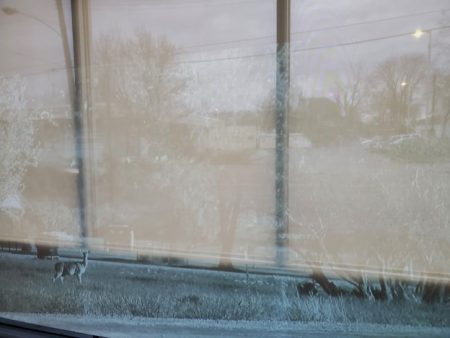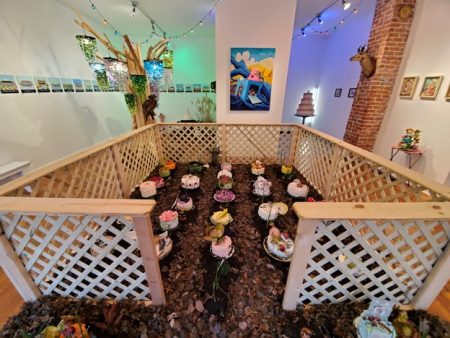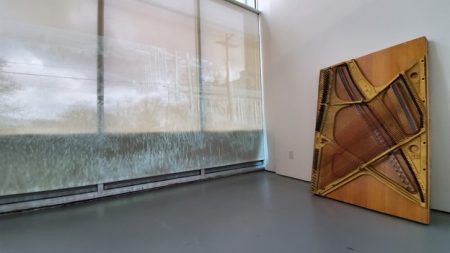
As a longtime resident of the Midwest I’ve come to know the region less as a single place but rather as a transient crossroads of many contradictory things. Maybe that’s why I’ve always been skeptical of attempts to reduce it to an essence, which in my experience resides more in the nebulous than the nameable. Two simultaneous (but unrelated) exhibitions at Wave Pool and Thunder-Sky galleries have done a fine job at circumlocuting something of a Midwestern essence without succumbing to the trap of definition.
At Wave Pool, Cincinnati-based curator Sso-Rha Kang explores the transcendental nature of place, in particular the “subtle sensory experiences inspired by the banalities of the Midwest.” Sentiments of Here charges the space between its three works with evocations that encircle them like transparent nesting dolls. Much of these evocations emanate from the dialog between works by Snow Yu and the collective Intermedio, situated in the corner of the gallery. These are anchored by Mark Albain’s less-active but equally crucial “Nicotine”, in which the gallery’s central wall has been covered in a grid of photocopy prints depicting a scrambled still life of dried flowers and burning cigarettes.
In Yu’s looping video “YOU were never really here”, we see black and white footage of deer crossing country roads. Projected low on a transparent scrim hanging over the gallery’s front window, we’re invited to contemplate these intersections — not only between road and animal, but also between the video (or gallery) and the outside, which is visible through the scrim. The movement of vehicles along Colerain Avenue becomes a part of the video, along with pedestrians, buildings, trees, power lines, and clouds. It’s like peering into a juncture between parallel worlds.
Intermedio’s “Phosphenes in the Snow”, in which the wood and metal guts of an old piano lean against an adjacent wall, multiplies these junctures. Just as Yu’s video encompasses the outside, sound emanating from hidden speakers mingles with the gallery’s aural environment: the low vibrations of the HVAC; the whine of a circular saw from the adjoining wood shop; the muted sounds from passing vehicles. From the board itself, there are chirping birds and distant trains and resonant chimes and chords.
These two works and the outside world move at three speeds: 1) the video’s shorter loop, cuts and camera movements that sink into a rhythm after a few cycles; 2) Intermedio’s much longer sound loop, continually shifting from one idea to the next; and 3) slowest of all, the outside, which rather consists of many interlocking loops: the regularity of traffic, trees swaying from side to side, and so on.

While Sentiments of Here explores the Midwest through a sparse vocabulary of evocations, Thunder-Sky’s Leap Year Cake Farm (curated by Bill Ross) is an everything-but-the-kitchen-sink celebration of regional eccentricity. This group show is Midwestern to its core, to the tune of “Bebop-a-Rebop Rhubarb Pie”. For all its wacky maximalism, Leap Year Cake Farm is every bit as transcendental as Sentiments of Here. I could (and was indeed tempted to) write this review as one blindfolded. There’s the smell of damp earth and decomposing leaves mingling with bright notes of sugar frosting and the sweet smell of sawdust.
Much of this emanates from the show’s stupendous central installation, in which cakes seem to grow from furrowed soil spread over the gallery floor. Created by pastry artist Sharon Butler, the 27 cakes are bizarre chimera of vegetable, confection, and yard sale. There’s corn-on-the-cob cake, farm animals cake, tomato cake, swimming pool cake, and broken headphones cake (to name a few). Mirroring my own delight, a taxidermy raccoon presides at the end in a gleeful pose of jubilation. Taxidermist Jeremy Johnson has contributed several specimens. (Were it not for the preponderance of actual confections, I’d be tempted to say these critters are the icing on the exhibition’s cake. Alas.)
Like any good collection of bric-a-brac, artful juxtapositions are this show’s lifeblood. Consider Katherine Michael’s 36 paintings of pies and cakes. Moving along the wall, where they’re installed in a neat line, I appreciate how each in turn evokes a particular flavor that I can almost taste (blueberry… strawberry… cherry… chocolate… rhubarb… etc.), and the scent of pine grows stronger closer to Jessica Wolf’s “Chandelier Tree”. It’s like Proust’s madeleine run through a blender at an Indiana hardware store.
At the exhibition’s opening in early January, the smalltalk du jour was the day’s unseasonable temperature of 70 degrees, and the night’s balmy air had me brooding about global warming. What will we call the Midwest when southern states become too warm for habitation? It struck me “Leap Year Cake Farm” might as much be a funeral, or a party welcoming whatever challenges and opportunities comes next. In Bill Ross’s painting “What To Do With The Unspeakable” we see four young possums clinging to their mother’s back above a soon-to-be-buried birthday cake, aflame with candles, perhaps a reminder of the spinning dance between birth and death (or trash and treasure, as say the possum-poets of old).
Returning to Sentiments of Here, I found myself thinking a lot about Snow Yu’s video and the use of the window scrim. What fascinates me is that, at least in daylight, there’s an asymmetry of visibility: from inside the gallery, I can see outside. But from the outside, the interior is hidden. Initially I found this troubling. What does it mean to appropriate this outside world as an object of aesthetic appreciation? Considering Wave Pool’s social practice initiatives in the surrounding Camp Washington neighborhood, “visibility” is ethically loaded.
I walked outside to see if this would change my perspective. I heard the sound of someone pressing buttons on the ATM across the street and realized that I had heard the same sound inside the gallery, coming from “Phosphenes in the Snow”. Then I noticed chirping birds and distant trains, and it clicked: the recordings Intermedio incorporated weren’t arbitrary. They were taken from the environment in the surrounding neighborhood. Ah!

In the context of Wave Pool’s social practice work, this is a radical, positive inversion of neoliberal place-making. In more insidious incarnations (elsewhere), this practice converts a community into a signal/noise ratio, ultimately commodifying that community’s individual and collective agency and subverting it to the will of whomever is in control. What makes this exhibition radical (or rather its proposition radical) is that it switches the wires: the aspects of the environment that might have been deprioritized for their lack of particularity are, instead, prioritized as signal. It amplifies the visibility (so to speak) of the banalities that make this place here and not somewhere else, but without exerting control on how it is defined. Maybe instead of placemaking we should have heremaking, which might be accomplished through such aesthetic tactics.
Leap Year Cake Farm does something along these lines, too, with a spirit of generosity that suffuses the exhibition. It’s generally true of Thunder-Sky that its sense of place emerges from its sense of community. The “Thunder-Sky aesthetic”, in full force here, emerges from that valence.
I’m reminded of the famous line in Ralph Ellison’s Invisible Man: “Perhaps to lose a sense of where you are implies the danger of losing a sense of who you are.” Whether with rhubarb pie paintings or deconstructed pianos, these exhibitions tell of art’s capacity to show us where we are so, perhaps, we can gain a better sense of who we are.
–Steve Kemple
